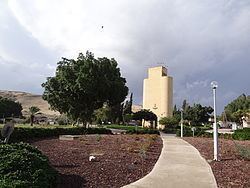Population (2015) 425 | Council Valley of Springs Founded 1939 Local time Monday 8:09 AM | |
 | ||
Weather 16°C, Wind S at 11 km/h, 79% Humidity | ||
Gesher (Hebrew: גֶּשֶׁר, lit. Bridge) is a kibbutz in the Beit She'an Valley in northeastern Israel. Founded in 1939 by immigrants from Germany, it falls under the jurisdiction of Valley of Springs Regional Council. It is situated 10 km south of kibbutz Deganya Aleph and 15 km south of Tiberias. The population is approximately 500 inhabitants. It is named after the neighbouring bridge over the Jordan river ("gesher" means bridge in Hebrew), known as Jisr el-Majami in Arabic and as Gesher Naharayim in Hebrew. The original site of the kibbutz, abandoned after the 1948 war, is known as Old Gesher. In 2015 it had a population of 425.
Contents
Map of Gesher, Israel
History
The kibbutz was founded in 1939 on lands bought with the help of Edmond de Rothschild, by a group of Jews born in Palestine who were members of the youth movement HaNo'ar HaOved and a group of young Jews from Germany. They were later joined by Jewish immigrants from Poland, Germany, Austria and additional Palestinian Jews. The kibbutz grew up near the Naharayim bridge as a Tower and stockade settlement.
The site of the kibbutz was a khan from the Mamluk period to the late 18th or early 19th century. Called Jisr el-Majami' (bridge of the meeting), it was one of the earliest khans in the Galilee and was a major crossroads where the north–south Bet She’an–Damascus road intersected the east–west road which led from the Gilead through the Sirin Plateau. Some of the original kibbutz buildings lay within the ruins. There are three bridges at the site - a Byzantine stone bridge, an Ottoman railroad bridge serving the Haifa-Dera'a segment of the Hejaz Railway, and a British Mandate road bridge serving the Haifa-Baghdad highway.
On 27 April 1948, the Haganah took control of the Gesher police station, a Tegart fort that had been evacuated by the British. The Arab Legion, still under British control at the time, ordered them to evacuate it. Haganah refused and both troops exchanged fire during 3 days until the Arab Legion was ordered by his HQ to return to their barracks.
In April–May 1948, 50 children of the kibbutz were evacuated to a 19th-century French monastery on the grounds of Rambam hospital in the Bat Galim neighborhood of Haifa, where they lived for 22 months.The building had been empty since 1933, when the Carmelite nuns had moved into their new monastery on the French Carmel.
For seven days, beginning on May 15, 1948, the kibbutz and Tegart fort were attacked by Iraqi forces using armored cars and aerial bombing.The defenders repulsed the Iraqis, inflicting heavy losses, but the kibbutz was destroyed during combat. After the war, the kibbutz was rebuilt about 1 km to the west.
During the War of Attrition between 1967 and 1970 the kibbutz was attacked with bombs, mines and gunfire by PLO Arab Palestinian fighters. In the 1990s it underwent privatization while preserving the collective model in the areas of education, health, culture and leisure.
After the peace agreement between Israel and the Kingdom of Jordan, the kibbutz established a museum on the original site of the kibbutz that documents the history of Gesher and the Jewish-run power station of Naharayim.
